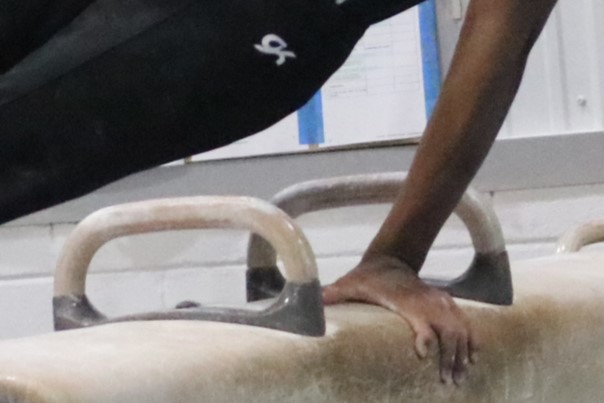Summary
Pommel horse is known as the toughest event in men’s gymnastics, with many gymnasts finding it frustrating and hard to enjoy. Here’s why:
- Slow Learning Curve: Learning the basic circle takes months to years, and the process is repetitive and tedious.
- Limited Skill Transfer: Skills from other events don’t transfer well to pommel horse, so training is very specific.
- Physical Strain: Wrist and elbow overuse, as well as many minor scrapes and bruises contribute to the physical toll of pommel horse.
- Frequent Falls: Small mistakes often lead to falls, which can be discouraging.
- Technical Complexity: It’s hard to progress because even advanced skills rely on perfecting the basics.
- Mental Fatigue: The repetitive nature and lack of excitement can be draining for athletes.
Overall, pommel horse is challenging both physically and mentally, which is why many gymnasts struggle to enjoy it and view it as the most difficult event.
In men’s gymnastics, pommel horse is generally regarded as the most difficult event. Many gymnasts don’t like the event.
But what exactly makes the event so difficult? And why don’t most gymnasts enjoy horse?
Although difficulty is subjective, we can point to a few different reasons that pommel horse is so hard.
Basics of Horse Are Tough
In the sport of gymnastics, each event has a set of basic skills that form the foundations of almost all other skills in that event. Most of the time these basic skills are relatively quick to learn, although difficult to master. On horse however, these basics are both slow to learn and difficult to master.
The Circle is the foundation of the pommel horse, and learning the circle is slow and tedious.
Consider, for example, how quickly a young gymnast can learn a cartwheel on the floor. This leads quickly to other skills, like the round-off. On Horse, it may take months or years before a gymnast can string together more than one circle on the mushroom. Usually, going from 0 to 1 circle takes longer than going from 1 to 10 circles.
Learning circles is an extremely tedious process. There are not a variety of drills and variations to keep training fresh and interesting. Circles are not a thrilling skill for the athlete to perform and the coach to watch. Because of this, the process of getting that first circle takes a long time that feels like forever. Most young gymnasts would rather be doing another event.
Lack of Skill Transfer with Other Events
One reason learning a circle takes so long is that the basics of other events do not carry over to a circle. Most events in gymnastics share some level of basic skills. The handstand is used for every event. Korbet actions are shared between most events, as are the underlying hollow and arch positions. High bar, still rings, and parallel bars all involve hanging skills. Floor and Vault share running, tumbling, and acrobatics. Training these events often results in improvements in other events.
The basics of most events in Men’s Gymnastics don’t transfer well to the basics of the pommel horse.
The Circle on pommel horse shares very little with other events. The circle does not involve a handstand. Although a circle does use basic shapes of hollow and arch, the ideal position of a circle is somewhat a mix between a hollow and an arch that isn’t quite the same as what is trained on other events. There is no hanging swing, no acrobatics, or tumbling. You can really only train horse by training specifically for horse.
Roadblocks to Skill Progress
Once a gymnast can do 10+ circles on the mushroom, then they can start learning different skills on horse. Each of these skills – stockli’s, flairs, spindles, russians – is a variation of a circle. If their basic circle isn’t high quality, it becomes difficult to learn these new skills.
Then, once all of these skills are learned on the mushroom, gymnasts have to learn these skills on the pommel horse. For many, learning to loop on a horse with pommels or circle on the handles is like relearning circles all over again. Tedious and long.
The other basic elements on pommel horse are single leg swings and scissors. Composing an entire element group of their own, these skills are also not very similar to circles. Although not as difficult to learn as circles, scissors are not easy on their own. Fortunately, these skills transfer well with support swings on parallel bars and benefit from the upper body strength and endurance developed from supporting a circle.
Dominance of Specialists on Pommel Horse
Looking deeper at how specialized horse is, we can see that Pommel Horse specialists dominate the apparatus at the elite level. Let’s take a look at the medalists from the last three Olympics:
- 2024: Rhys McClenaghan, Nariman Kurbanov, Stephen Nedoroscik
- 2020: Max Whitlock, Lee Chih-kai, Kazuma Kaya
- 2016: Max Whitlock, Louis Smith, Alex Naddour
McClenaghan, Karbanov, and Nedoroscik were all Pommel Horse specialists. Likewise, Smith was a Pommel Horse specialist, who also earned silver at the 2012 London Olympics. Likewise, although Whitlock, Chih-kai, and Naddour were not specialists, Pommel Horse were their specialties, focusing much of their time on that apparatus. The dominance of the horse specialist goes to show how Pommel Horse is almost a sport on its own.
Physics and Math: Why Falls Are So Common On Pommel Horse
While performing circles on the pommel horse, a gymnast is in an unstable equilibrium – any small displacement from balance results in the system continuing to push the object further from equilibrium.

With each hand placement on the horse, the gymnast has an opportunity to make a small mistake and lose balance. And there are a lot of opportunities to make errors on horse. On most events, gymnasts have limited opportunities to fall. It is difficult to fall on most skills on rings and vault consists of one skill. Other events, each skill normally offers only one opportunity to fall.
On the pommel horse, each hand placement of a circle is a chance to fall off the horse. There are two hand placements per circle, and many skills consist of multiple circles.
On pommel horse, a small margin of error combines with many opportunities to make mistakes, resulting in many falls.
Training Horse Is Pain: Bruises, Scrapes, and Wrist Overuse
If you ask many gymnasts, training horse is painful. Especially once athletes begin training with the handle, the risk of hitting the apparatus is high. That small margin for error and many opportunities for mistakes isn’t just a problem in competition, it means even more scrapes, collisions, and crashes during training.
Fortunately, the risk of severe injury on horse is not particularly high, but minor injuries like scrapes and bruises are quite common. It is pretty painful to clip your shin on the handle during circles.
The repetitive nature of horse also leads to wrist and elbow overuse injuries. During a circle, the wrists hold up the whole body weight as the gymnast swings. Over the course of a week of practice, a gymnast will accumulate hundreds of circles. Without proper injury prevention and workload management, this leads to wrist overuse. The same mechanisms also lead to elbow injuries like tennis or golfers elbow.
Wrist injuries creep up very slow. Unlike overuse injuries on other events like Rings or Floor, continuing to train on an injured wrist likely won’t cause an acute severe injury. So gymnasts continue to train on the wrists under chronic pain conditions. Consistent with the theme of horse, gymnasts often view training through pain as part of gritting through the challenge and tediousness of the event to become better.
Many Gymnasts Hate Pommel Horse
Pommel horse is the balance beam of men’s gymnastics. Girls do not like beam just as boys do not like horse.
The challenge of horse definitely gets to athletes. The tediousness and repetitive training of circles bores them. Gymnasts don’t enjoy falling, and they fall a lot on horse. Gymnasts sometimes attribute falling (sometimes correctly, sometimes incorrectly) to not being good enough at the horse.
The negativity around horse produces a cycle. Gymnasts face challenges with a negative mindset, which makes training less enjoyable. When the results aren’t as good from bad training, gymnasts enjoy horse less.
Certainly, for many gymnasts who enjoy the thrill of risk taking, pommel horse is not as exciting as an event like high bar. The horse lacks explosive skills and acrobatic finishes. Similarly, the horse does not involve displays of raw strength, like the strength holds on Still Rings.
Instead, steady rhythm and tempo defines horse, and the flashy allure of other events often draws athlete’s attention away from grinding through a tough horse practice.
Further Resources
Answering your questions about pommel horse

